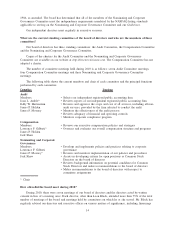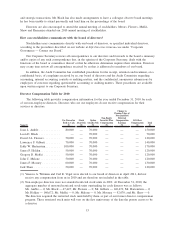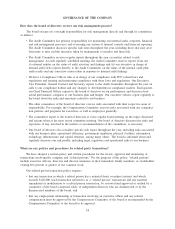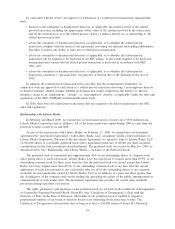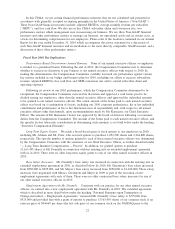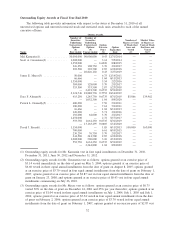XM Radio 2010 Annual Report Download - page 34
Download and view the complete annual report
Please find page 34 of the 2010 XM Radio annual report below. You can navigate through the pages in the report by either clicking on the pages listed below, or by using the keyword search tool below to find specific information within the annual report.subjected to in recent years, particularly with regard to pay packages that could be deemed excessive. In the
final analysis, the Compensation Committee believes that our ability to recruit and retain top executive talent
is essential to our long-term success. We operate in a highly competitive industry and the competition we face
is increasing. Accordingly, the Compensation Committee believes it has successfully balanced the sometimes
competing obligations to make decisions which meet the needs of our company against various “one-size-fits-
all” legislative, regulatory and “best practice” mandates.
The Compensation Committee regularly reviews our compensation practices to assess — in light of
current market conditions, the status of our business and development and our financial condition and
prospects — whether our existing compensation structure properly advances the near- and long-term interests
of our stockholders. The Compensation Committee did not employ a compensation consultant in 2010, relying
instead on the significant experience and informed judgment of its members in making executive compensa-
tion-related decisions.
The Compensation Committee does not attempt to set compensation levels for each executive within a
particular range related to levels provided by peers. Instead, the Compensation Committee occasionally uses
informal market comparisons as one of many factors in making compensation decisions. Other factors
considered when making individual executive compensation decisions include individual contribution and
performance, reporting structure, historical compensation, internal pay relationship, complexity and importance
of roles and responsibilities, leadership and growth potential.
In determining compensation element levels, including the annual grants of stock options, for each named
executive officer (other than the Chief Executive Officer); the Compensation Committee also consults with and
considers the recommendations and input of our Chief Executive Officer.
The Compensation Committee expects to review our compensation programs in 2011 with a view to
ensuring that they continue to provide the correct incentives and are properly sized given the scope and
complexity of our business and the competition we face. We have adopted a 2011 bonus program for our
named executive officers (other than our Chief Financial Officer) under our 2009 Long-Term Stock Incentive
Plan. The awards made under the bonus program are intended to qualify for the performance-based exception
under Section 162(m) of the Internal Revenue Code. The bonus program provides for a bonus pool which is
based on a percentage of EBITDA, provided that no bonus amount is payable if we do not achieve a specified
level of EBITDA. We expect to continue to respond to changes in economic conditions and our business with
innovation and flexibility, as needed, to advance our objectives of motivating, attracting and retaining high-
quality executives with the skills and experience necessary to achieve our key business objectives and increase
stockholder value.
Executive Compensation Elements
Our practices with respect to the primary compensation elements identified above, as well as other
elements of compensation, are described below, followed by a discussion of the specific factors considered in
determining key compensation elements for the named executive officers for 2010.
Base Salary
Objectives. The objective of base salary is to reflect job responsibilities, value to us, individual
performance and market competitiveness. Salaries often are reviewed in connection with the extension of an
employment agreement.
Process. Base salaries for named executive officers are determined consistent with their employment
agreements. The minimum salaries set forth in the employment agreements and the amount of any increase
over these salaries are determined by the Compensation Committee based on a variety of factors, including:
• the nature and responsibility of the position and, to the extent available and deemed relevant, salary
norms for persons in similar positions at comparable companies;
• the expertise and past performance of the individual executive;
24


